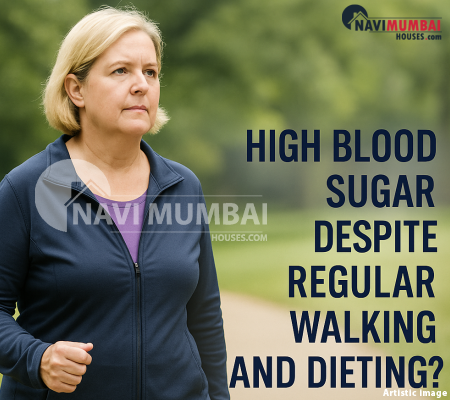
A 48-year-old woman, one year into menopause, came for a routine check-up with troubling numbers.
-
Fasting blood sugar: 128 mg/dL
-
HbA1c (3-month average): 6.4%
-
Post-meal sugar: 140 mg/dL
Despite being a consistent walker, carefully monitoring her diet, avoiding smoking and alcohol, and no family history of diabetes, she was alarmed by these rising numbers.
Many people believe that diet + exercise should suffice. But her case shows that health is multifactorial — sometimes, hidden internal changes overtake lifestyle benefits.
Why It Happens Despite Best Intentions
What was she overlooking? Several underlying factors played a role:
A. Menopause & Hormonal Changes
After menopause, estrogen levels fall sharply. Estrogen helps insulin work effectively and promotes glucose uptake into muscles. With estrogen down, insulin sensitivity decreases, making it harder for the body to manage blood sugar.
Menopause also triggers shifts in hormone balance: cortisol (stress hormone) may rise, and metabolic shifts favor abdominal fat accumulation — both of which worsen glucose control.
B. Muscle Mass & Strength Training Deficit
Walking helps, but walking alone may not build or maintain significant muscle mass. Muscles are prime glucose sinks — they pull sugar from the blood not just during, but after exercise. Without strength / resistance training, the body’s ability to clear glucose diminishes.
In another patient’s case, walking 45 minutes daily produced modest gains. But when strength training (squats, resistance bands) was added thrice a week, HbA1c dropped significantly over months.
C. “Dawn Phenomenon” & Internal Glucose Release
Even with disciplined diet and exercise, some people have persistently elevated fasting sugar due to internal liver glucose release early morning — a phenomenon called dawn phenomenon. The body’s rhythms release cortisol / glucagon, which signal the liver to emit stored glucose. If insulin response is insufficient, fasting sugar remains high.
D. Underestimation of Hidden Spikes / Snacking / Late Meals
Even small food choices — late night snacks, hidden sugars, glycemic load, glycemic index mismatches — can cause repeated glucose hits that accumulate. Some “dieters” may suppress main meals but snack often, or eat foods marketed “healthy” but with hidden sugars.
E. Other Contributory Factors
-
Poor sleep, chronic stress, underlying inflammation or illness
-
Possible micronutrient deficiencies (like Vitamin D, magnesium)
-
Genetic predisposition or latent pancreatic / beta-cell decline
-
Sedentary periods (sitting long after meals) reducing glucose use
All these act as hidden resistances against what diet+walking alone can overcome.
What She Can Do Next (Complement Lifestyle With Targeted Measures)
To get control, she needs a more holistic, layered approach beyond diet & walking.
1. Add Resistance / Strength Training
Incorporate strength training — bodyweight exercises, resistance bands, dumbbells — 2–3 times a week. This helps build lean muscle, improve insulin sensitivity, and improve basal glucose uptake.
2. Time & Quality of Exercise
Include post-meal walks (10–15 minutes after eating) to help muscles soak up glucose. Walking after meals is known to blunt postprandial sugar spikes.
Ensure variety: some higher-intensity intervals, some lighter activity; break prolonged sitting periods.
3. Assess Hormonal & Menopause-Related Treatment
Discuss hormone replacement therapy (HRT) — in some cases it helps glucose and lipid metabolism. But it must be assessed carefully for risks (cancer, thrombosis).
4. Monitor & Tailor Diet More Precisely
Track not just quantity but timing, glycemic index/load, carbohydrate type, and overall macronutrient balance. Even small hidden sugars or mismatched meal timing matter.
5. Use Continuous Monitoring (CGM) / Frequent Tests
Continuous glucose monitoring can reveal hidden glucose patterns (overnight, post-exercise, snacking). This helps to tailor interventions (meds, timing) more precisely.
Also monitor HbA1c, lipids, kidney/liver health, micronutrients, and hormone panels.
6. Manage Stress, Sleep & Secondary Health Factors
Reduce chronic stress (meditation, breathing, yoga). Ensure quality sleep (7–8 hours). Treat or rule out coexisting conditions (thyroid, inflammation).
7. Medical Review & Medication / Therapy As Needed
If lifestyle changes alone don’t suffice, discuss with an endocrinologist about whether early medication, insulin sensitizers, or tailored therapy may be needed.
Takeaways for Women in Perimenopause / Menopause
-
Don’t assume walking + diet will always be enough — internal changes (hormones, metabolism) may demand more targeted steps.
-
Start strength training early, not just cardio.
-
Get regular health checkups including glucose, hormones, and metabolic panels.
-
Be patient and responsive — small adjustments (exercise timing, snacking, sleep) can yield substantial change.
-
Always consult specialists (endocrinologist, gynecologist) especially when considering hormonal therapy.
The post Regular Walker, Healthy Eater — Yet Blood Sugar Rose: What Was Missing appeared first on .

